Jun Jin
RA-DP: Rapid Adaptive Diffusion Policy for Training-Free High-frequency Robotics Replanning
Mar 06, 2025Abstract:Diffusion models exhibit impressive scalability in robotic task learning, yet they struggle to adapt to novel, highly dynamic environments. This limitation primarily stems from their constrained replanning ability: they either operate at a low frequency due to a time-consuming iterative sampling process, or are unable to adapt to unforeseen feedback in case of rapid replanning. To address these challenges, we propose RA-DP, a novel diffusion policy framework with training-free high-frequency replanning ability that solves the above limitations in adapting to unforeseen dynamic environments. Specifically, our method integrates guidance signals which are often easily obtained in the new environment during the diffusion sampling process, and utilizes a novel action queue mechanism to generate replanned actions at every denoising step without retraining, thus forming a complete training-free framework for robot motion adaptation in unseen environments. Extensive evaluations have been conducted in both well-recognized simulation benchmarks and real robot tasks. Results show that RA-DP outperforms the state-of-the-art diffusion-based methods in terms of replanning frequency and success rate. Moreover, we show that our framework is theoretically compatible with any training-free guidance signal.
FRMD: Fast Robot Motion Diffusion with Consistency-Distilled Movement Primitives for Smooth Action Generation
Mar 03, 2025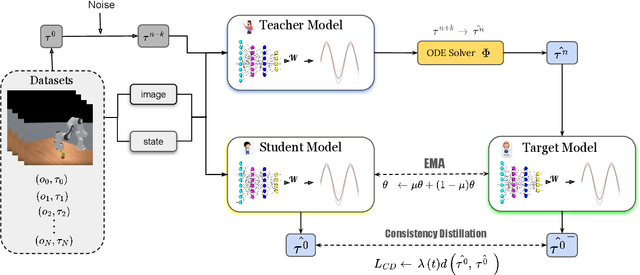
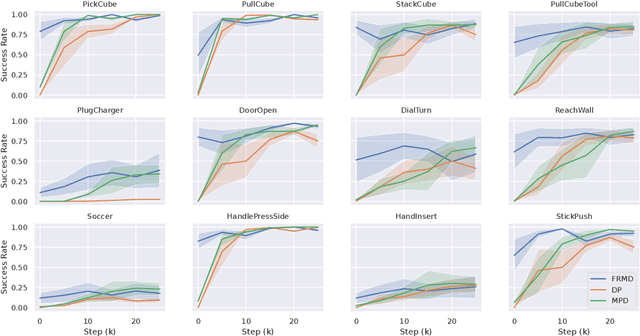
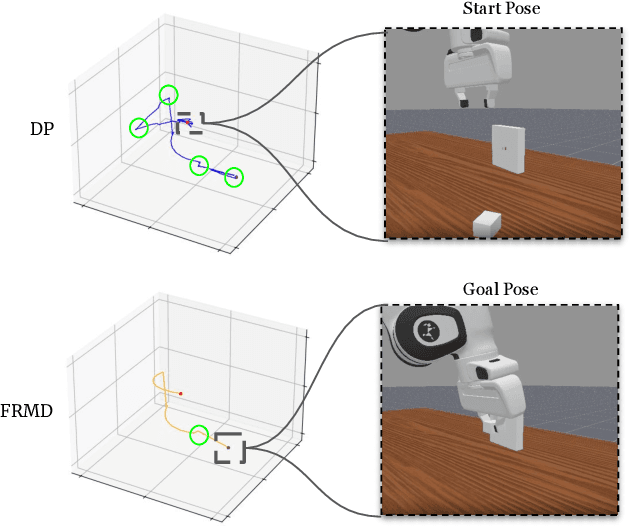
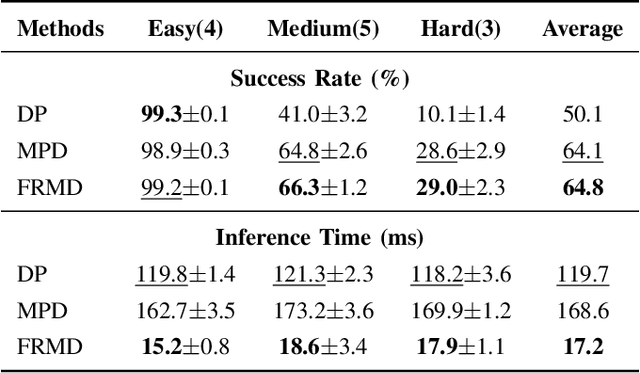
Abstract:We consider the problem of using diffusion models to generate fast, smooth, and temporally consistent robot motions. Although diffusion models have demonstrated superior performance in robot learning due to their task scalability and multi-modal flexibility, they suffer from two fundamental limitations: (1) they often produce non-smooth, jerky motions due to their inability to capture temporally consistent movement dynamics, and (2) their iterative sampling process incurs prohibitive latency for many robotic tasks. Inspired by classic robot motion generation methods such as DMPs and ProMPs, which capture temporally and spatially consistent dynamic of trajectories using low-dimensional vectors -- and by recent advances in diffusion-based image generation that use consistency models with probability flow ODEs to accelerate the denoising process, we propose Fast Robot Motion Diffusion (FRMD). FRMD uniquely integrates Movement Primitives (MPs) with Consistency Models to enable efficient, single-step trajectory generation. By leveraging probabilistic flow ODEs and consistency distillation, our method models trajectory distributions while learning a compact, time-continuous motion representation within an encoder-decoder architecture. This unified approach eliminates the slow, multi-step denoising process of conventional diffusion models, enabling efficient one-step inference and smooth robot motion generation. We extensively evaluated our FRMD on the well-recognized Meta-World and ManiSkills Benchmarks, ranging from simple to more complex manipulation tasks, comparing its performance against state-of-the-art baselines. Our results show that FRMD generates significantly faster, smoother trajectories while achieving higher success rates.
LaFFi: Leveraging Hybrid Natural Language Feedback for Fine-tuning Language Models
Dec 31, 2023Abstract:Fine-tuning Large Language Models (LLMs) adapts a trained model to specific downstream tasks, significantly improving task-specific performance. Supervised Fine-Tuning (SFT) is a common approach, where an LLM is trained to produce desired answers. However, LLMs trained with SFT sometimes make simple mistakes and result in hallucinations on reasoning tasks such as question-answering. Without external feedback, it is difficult for SFT to learn a good mapping between the question and the desired answer, especially with a small dataset. This paper introduces an alternative to SFT called Natural Language Feedback for Finetuning LLMs (LaFFi). LaFFi has LLMs directly predict the feedback they will receive from an annotator. We find that requiring such reflection can significantly improve the accuracy in in-domain question-answering tasks, providing a promising direction for the application of natural language feedback in the realm of SFT LLMs. Additional ablation studies show that the portion of human-annotated data in the annotated datasets affects the fine-tuning performance.
EmbodiedGPT: Vision-Language Pre-Training via Embodied Chain of Thought
May 24, 2023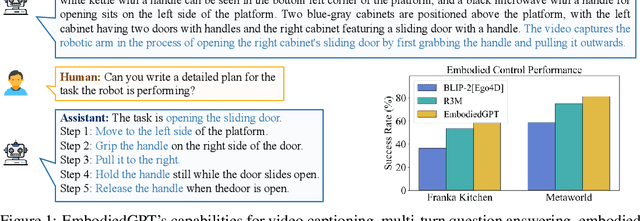

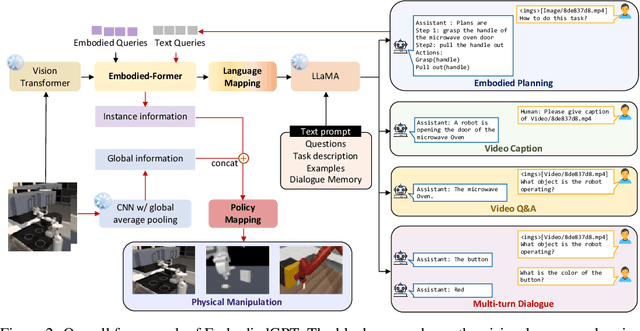

Abstract:Embodied AI is a crucial frontier in robotics, capable of planning and executing action sequences for robots to accomplish long-horizon tasks in physical environments. In this work, we introduce EmbodiedGPT, an end-to-end multi-modal foundation model for embodied AI, empowering embodied agents with multi-modal understanding and execution capabilities. To achieve this, we have made the following efforts: (i) We craft a large-scale embodied planning dataset, termed EgoCOT. The dataset consists of carefully selected videos from the Ego4D dataset, along with corresponding high-quality language instructions. Specifically, we generate a sequence of sub-goals with the "Chain of Thoughts" mode for effective embodied planning. (ii) We introduce an efficient training approach to EmbodiedGPT for high-quality plan generation, by adapting a 7B large language model (LLM) to the EgoCOT dataset via prefix tuning. (iii) We introduce a paradigm for extracting task-related features from LLM-generated planning queries to form a closed loop between high-level planning and low-level control. Extensive experiments show the effectiveness of EmbodiedGPT on embodied tasks, including embodied planning, embodied control, visual captioning, and visual question answering. Notably, EmbodiedGPT significantly enhances the success rate of the embodied control task by extracting more effective features. It has achieved a remarkable 1.6 times increase in success rate on the Franka Kitchen benchmark and a 1.3 times increase on the Meta-World benchmark, compared to the BLIP-2 baseline fine-tuned with the Ego4D dataset.
A Simple Decentralized Cross-Entropy Method
Dec 16, 2022Abstract:Cross-Entropy Method (CEM) is commonly used for planning in model-based reinforcement learning (MBRL) where a centralized approach is typically utilized to update the sampling distribution based on only the top-$k$ operation's results on samples. In this paper, we show that such a centralized approach makes CEM vulnerable to local optima, thus impairing its sample efficiency. To tackle this issue, we propose Decentralized CEM (DecentCEM), a simple but effective improvement over classical CEM, by using an ensemble of CEM instances running independently from one another, and each performing a local improvement of its own sampling distribution. We provide both theoretical and empirical analysis to demonstrate the effectiveness of this simple decentralized approach. We empirically show that, compared to the classical centralized approach using either a single or even a mixture of Gaussian distributions, our DecentCEM finds the global optimum much more consistently thus improves the sample efficiency. Furthermore, we plug in our DecentCEM in the planning problem of MBRL, and evaluate our approach in several continuous control environments, with comparison to the state-of-art CEM based MBRL approaches (PETS and POPLIN). Results show sample efficiency improvement by simply replacing the classical CEM module with our DecentCEM module, while only sacrificing a reasonable amount of computational cost. Lastly, we conduct ablation studies for more in-depth analysis. Code is available at https://github.com/vincentzhang/decentCEM
Variable-Decision Frequency Option Critic
Dec 11, 2022

Abstract:In classic reinforcement learning algorithms, agents make decisions at discrete and fixed time intervals. The physical duration between one decision and the next becomes a critical hyperparameter. When this duration is too short, the agent needs to make many decisions to achieve its goal, aggravating the problem's difficulty. But when this duration is too long, the agent becomes incapable of controlling the system. Physical systems, however, do not need a constant control frequency. For learning agents, it is desirable to operate with low frequency when possible and high frequency when necessary. We propose a framework called Continuous-Time Continuous-Options (CTCO), where the agent chooses options as sub-policies of variable durations. Such options are time-continuous and can interact with the system at any desired frequency providing a smooth change of actions. The empirical analysis shows that our algorithm is competitive w.r.t. other time-abstraction techniques, such as classic option learning and action repetition, and practically overcomes the difficult choice of the decision frequency.
CWD: A Machine Learning based Approach to Detect Unknown Cloud Workloads
Nov 28, 2022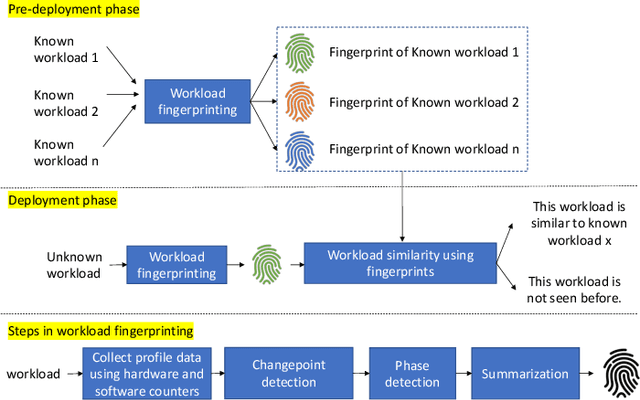
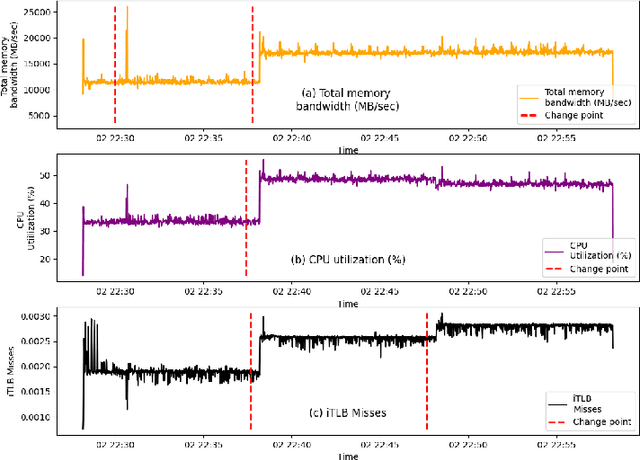
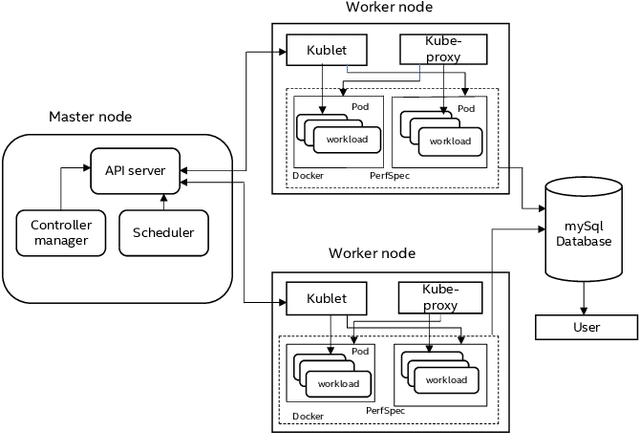
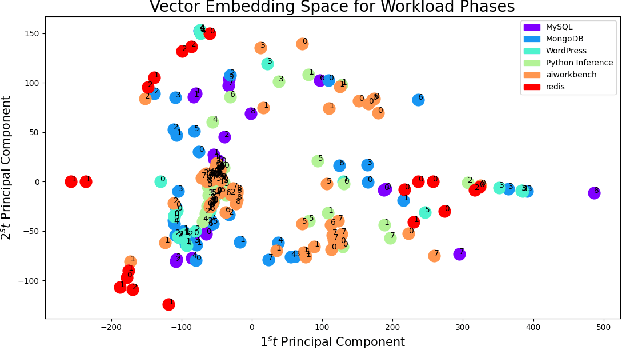
Abstract:Workloads in modern cloud data centers are becoming increasingly complex. The number of workloads running in cloud data centers has been growing exponentially for the last few years, and cloud service providers (CSP) have been supporting on-demand services in real-time. Realizing the growing complexity of cloud environment and cloud workloads, hardware vendors such as Intel and AMD are increasingly introducing cloud-specific workload acceleration features in their CPU platforms. These features are typically targeted towards popular and commonly-used cloud workloads. Nonetheless, uncommon, customer-specific workloads (unknown workloads), if their characteristics are different from common workloads (known workloads), may not realize the potential of the underlying platform. To address this problem of realizing the full potential of the underlying platform, we develop a machine learning based technique to characterize, profile and predict workloads running in the cloud environment. Experimental evaluation of our technique demonstrates good prediction performance. We also develop techniques to analyze the performance of the model in a standalone manner.
Build generally reusable agent-environment interaction models
Nov 13, 2022


Abstract:This paper tackles the problem of how to pre-train a model and make it generally reusable backbones for downstream task learning. In pre-training, we propose a method that builds an agent-environment interaction model by learning domain invariant successor features from the agent's vast experiences covering various tasks, then discretize them into behavior prototypes which result in an embodied set structure. To make the model generally reusable for downstream task learning, we propose (1) embodied feature projection that retains previous knowledge by projecting the new task's observation-action pair to the embodied set structure and (2) projected Bellman updates which add learning plasticity for the new task setting. We provide preliminary results that show downstream task learning based on a pre-trained embodied set structure can handle unseen changes in task objectives, environmental dynamics and sensor modalities.
Auxiliary task discovery through generate-and-test
Oct 25, 2022Abstract:In this paper, we explore an approach to auxiliary task discovery in reinforcement learning based on ideas from representation learning. Auxiliary tasks tend to improve data efficiency by forcing the agent to learn auxiliary prediction and control objectives in addition to the main task of maximizing reward, and thus producing better representations. Typically these tasks are designed by people. Meta-learning offers a promising avenue for automatic task discovery; however, these methods are computationally expensive and challenging to tune in practice. In this paper, we explore a complementary approach to the auxiliary task discovery: continually generating new auxiliary tasks and preserving only those with high utility. We also introduce a new measure of auxiliary tasks usefulness based on how useful the features induced by them are for the main task. Our discovery algorithm significantly outperforms random tasks, hand-designed tasks, and learning without auxiliary tasks across a suite of environments.
What makes useful auxiliary tasks in reinforcement learning: investigating the effect of the target policy
Apr 01, 2022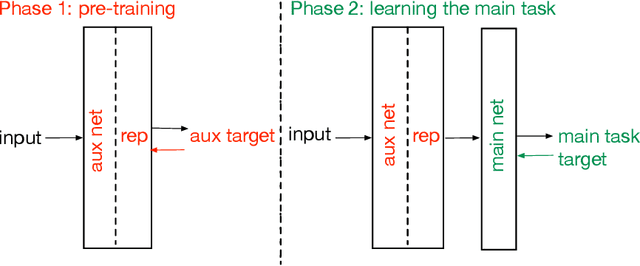


Abstract:Auxiliary tasks have been argued to be useful for representation learning in reinforcement learning. Although many auxiliary tasks have been empirically shown to be effective for accelerating learning on the main task, it is not yet clear what makes useful auxiliary tasks. Some of the most promising results are on the pixel control, reward prediction, and the next state prediction auxiliary tasks; however, the empirical results are mixed, showing substantial improvements in some cases and marginal improvements in others. Careful investigations of how auxiliary tasks help the learning of the main task is necessary. In this paper, we take a step studying the effect of the target policies on the usefulness of the auxiliary tasks formulated as general value functions. General value functions consist of three core elements: 1) policy 2) cumulant 3) continuation function. Our focus on the role of the target policy of the auxiliary tasks is motivated by the fact that the target policy determines the behavior about which the agent wants to make a prediction and the state-action distribution that the agent is trained on, which further affects the main task learning. Our study provides insights about questions such as: Does a greedy policy result in bigger improvement gains compared to other policies? Is it best to set the auxiliary task policy to be the same as the main task policy? Does the choice of the target policy have a substantial effect on the achieved performance gain or simple strategies for setting the policy, such as using a uniformly random policy, work as well? Our empirical results suggest that: 1) Auxiliary tasks with the greedy policy tend to be useful. 2) Most policies, including a uniformly random policy, tend to improve over the baseline. 3) Surprisingly, the main task policy tends to be less useful compared to other policies.
 Add to Chrome
Add to Chrome Add to Firefox
Add to Firefox Add to Edge
Add to Edge